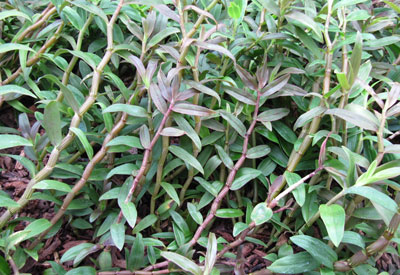Pre-planting Cultivation Techniques of Dendrobium candidum in Greenhouse
Dendrobium candidum, the orchid family Dendrobium, most species are concentrated in the north latitude 15 ° 30 '~ 25 ° 12' between the wild, Dendrobium candidum growing in the altitude of 100-3000 meters above sea level, often attached to the tree On or on the rocks. Hi warm, moist and semi-shade environment, not cold. The optimum temperature for growth is 18 to 30°C, and the growth period is more suitable for 16 to 21°C. Our country is mainly distributed in Yunnan, Guangxi, Guangdong, Guizhou, Taiwan and other places. The following is a brief introduction of the cultivation techniques before the planting of Dendrobium candidum in greenhouses for your reference:

1. Preparation of cultivation substrates. Transplanting Dendrobium candidum seedlings to choose the appropriate matrix. The root of Dendrobium candidum is an aerial root, with obvious aerobic and shallow roots. Therefore, the matrix is ​​required to have loose air, good drainage, less pathogenic bacteria and potential pests. It is difficult for a single matrix to meet the requirements of water retention and breathability at the same time. We can choose to mix sphagnum moss, limestone, broken bricks, sawdust powder, bark, shavings, fern roots, slats, sphagnum moss, and hibiscus. (Because sawdust and other organic substrates with high carbon-to-nitrogen ratios have a long fermentation time, it is possible to use the Trilobite substrate nutrient-fermented fermentation mixture to not only shorten the fermentation time, but also convert the nutrients in the material through high-temperature fermentation. Reduce the amount of late fertilizer application, and the fermentation material also contains many beneficial microorganisms, these microorganisms can form a protective layer around the root of Dendrobium candidum, effectively prevent root diseases, and other microbial metabolites such as cytokinins, gibberellins, quinones Acetic acid and the like can also stimulate root growth.) The optimum matrix ratio for actual production is a peat:bark:fine wood shavings=2:4:4 matrix formulation. As the fine sawdust is too fine and its permeability is poor, it can easily lead to compaction, which limits the growth of the root system of Dendrobium candidum.
2, timely transplanting. (1) The best season for transplanting should be when the average daily temperature is between 15°C and 30°C. The temperature is too low or too high to be bottled and transplanted. In general, the main origin of Dendrobium can be planted except for the coldest season. In the greenhouse, planting Dendrobium candidum, spring equinox to Qingming, and autumnal equinox, transplanting in these two periods of time, is the period of transplanting with the highest survival rate. (2) Carefully remove the tissue culture seedlings without damaging the root system. After the seedlings have been bottled, gently rinse the culture medium at the roots of the seedlings. If the medium is transplanted, the nutrient content of the medium is likely to become bacteria and cause rot, which lowers the survival rate. After the tissue culture seedlings are washed, they are soaked in 500-800-fold dilutions of 500-800 times with a jinbab root seedling and soaked for 15 minutes in seconds. (Kimbo root seedlings contain active rooting agents, virus inhibitors, and BYM microbial fermentation broth, etc. The root can reduce the root disease of the seedlings, promote fibrous root growth and increase the root absorption capacity, and the seedling grows vigorously. After soaking, the seedlings are placed on a good water-absorbent object, and dried naturally under the scattered light for 5-7 hours.
3, colonization. After the seedlings have been soaked, use a spade or finger to dig a 3–5 cm deep seedling hole in the substrate and dig a seedling hole. Then the roots of the seedlings are straightened and put into the seedling hole to cover the substrate. After implanting, it forms a tightly loosened state. Be careful not to break the fleshy root of the sarcophagus, then cover it with a substrate. Bare root seedlings or less rooted shoots are best kept separate for easy management. Plant spacing is generally 10cm x 13cm. Density can also be determined depending on local conditions or your own planting experience. After the completion of transplanting, 50% carbendazim wettable powder 1000 times liquid was used for disinfection by foliar spray. During the first week after transplanting, the relative humidity of the air should be maintained at 90%. At this stage, it is best to use a 90-mesh shade net. After three days of transplanting, a golden beetroot root seedling is sprayed 800 times, or the golden baby microbial fertilizer (granules) is soaked and diluted 800 times for foliar spray. The purpose is to increase the seedling survival rate and promote rooting. Details can be consulted: Beijing Huaxia Kangyuan Technology Co., Ltd. telephone toll-free hotline
Recommended reading
1, Jinbao matrix fermentation agent to create a perfect Dendrobium seedling substrate
2, the use of gold substrate fermentation agent Dendrobium benefits
Natural Field cosmetics raw material extracted from plants contain highly-pure and standardized active substances. They are mainly used to improve skin and hair health and appearance. The strong ingredients are: 5-Aminolevulinic acid, Idebenone, Chlorogenic acid, Polydatin. Etc.
Cosmetics are natural, synthetic or extracted various effects of different substances as raw materials, heating, stirring and emulsification and other production processes from the chemical mixture. It is a compound mixture of various raw materials after reasonable mixing and processing. The raw materials of cosmetics are various in variety and performance. According to the properties and USES of cosmetic materials, they can be divided into two categories: matrix materials and auxiliary materials.
The former is a kind of main raw material of cosmetics, which occupies a large proportion in the cosmetics formula and plays a major role in the cosmetics. The latter plays a role in shaping, stabilizing, or imparting color, fragrance, and other properties to cosmetics, which are not used in large amounts in cosmetic formulations but are extremely important.
Skin Whitening,anti-aging,arbutin,kojic acid,fullerenes
PYSON Co. ,Ltd. , https://www.pysonbio.com